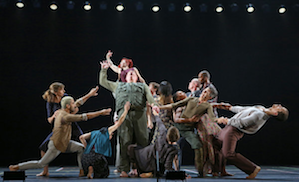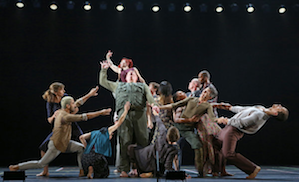
Photo by Ruby Washington
And the Rites keep right on coming, this centennial year of Igor Stravinsky’s The Rite of Spring. Each version is different, of course, thanks to aesthetics and world view and oh, a bunch of other things, some of which are spoken of by participants in the new, perplexing and engaging dance/theater piece, a collaboration by Bill T. Jones, his associate artistic director Janet Wong, and Anne Bogart. A Rite opened Friday and ends Sunday at the Lam Research Theater.
A Rite was part of Yerba Buena Center for the Arts’ 30th anniversary celebration of the Bill T. Jones/ Arnie Zane Dance Company, marked with film, an art exhibition, a collaboration last week with Counterpulse, a master class and discussions with Jones and others.
Bogart is artistic director of the SITI Company, an ensemble she cofounded with Tadeo Suzuki in 1992. SITI’s mission statement speaks of “a gymnasium for the soul,” which makes it a great fit with Jones’ company, whose eloquence stretches beyond the borders of dance. Jones’ choreography drives the piece. There are nine dancers and six actors onstage, give or take, wearing clothes in drab colors, designed by James Schuette.
SITI’s actors speak throughout A Rite, and are first distinguishable onstage by their mics, but their physicality comes across loud and clear. They can move with intent, unity and dispatch, though they don’t storm into spins, lifts, and leaps the way Jones’ dancers do; among the standout dancers were Antonio Brown, Talli Jackson, and Shayla-Vie Jenkins. “Storm” is often the operative word, for this Rite embodies anger and despair, first personified by actor Will Bond as a traumatized World War I doughboy (we can tell from his khaki, his gaiters, and his derangement).
The ballet premiered the year before the outbreak of World War I. I can’t think of another take on Rite of Spring that binds it so literally to that shattering event.
Though there’s only one soldier, he’s one of the two central figures. The other is a prim-looking music scholar (Ellen Lauren) with a folksy Midwestern accent and a polka-dot dress who will unload one overblown Rite of Spring analysis after another, to general merriment. She’s sort of a cross between Gilda Radner’s Emily Littella on Saturday Night Live and Ruth Buzzi’s spinster on Laugh-In. Then there’s a clueless scientist, Stephen Duff Webber, who offers lab-based rationales for why the Rite is the way it is.
Clearly, none of these is entirely satisfactory. Perhaps the wounded warrior comes the closest to embodying the chaos and unrest of an era when opening night of The Rite of Spring produced a riot at the theater.
The sense of urgency conveyed in A Rite’s unified, surging movement across the dark and barren stage, the fragmented and disordered arrangement of excerpts of the music recorded by various orchestras, the wry humor, the bursts of song that offset the soldier’s tragic demeanor, the harshness of Robert Wierzel’s lighting design — suspended bulbs and a foggy miasma as the piece, an hour long, begins — well, that could all stand for universal upheaval.
But as A Rite says, the impresario Serge Diaghilev could have craftily set up the riot in the theater to divert attention from the choreographer, Vaslav Nijinsky, whose romantic attentions had turned away from Diaghilev.
You see the problem. You see the paradoxes. Where is the truth? What can it matter? What did Stravinsky intend, and what about Nijinsky? For that matter, what was in the mind of Diaghilev?
And — of course and always — there’s more. What is the purpose of performance? How is an authentic work of art, of dance or theater or both, created, and what are we to take away from our hour with this wonderfully impassioned company?
For this onlooker, the truth lies with that soldier. The idea — particularly as he marched backward in the stroboscopic lighting at the end of the piece — seemed to be that war is an eternal and infernal definer of human existence. Everything else is just an attempt to understand it, with the aim of ending it.

